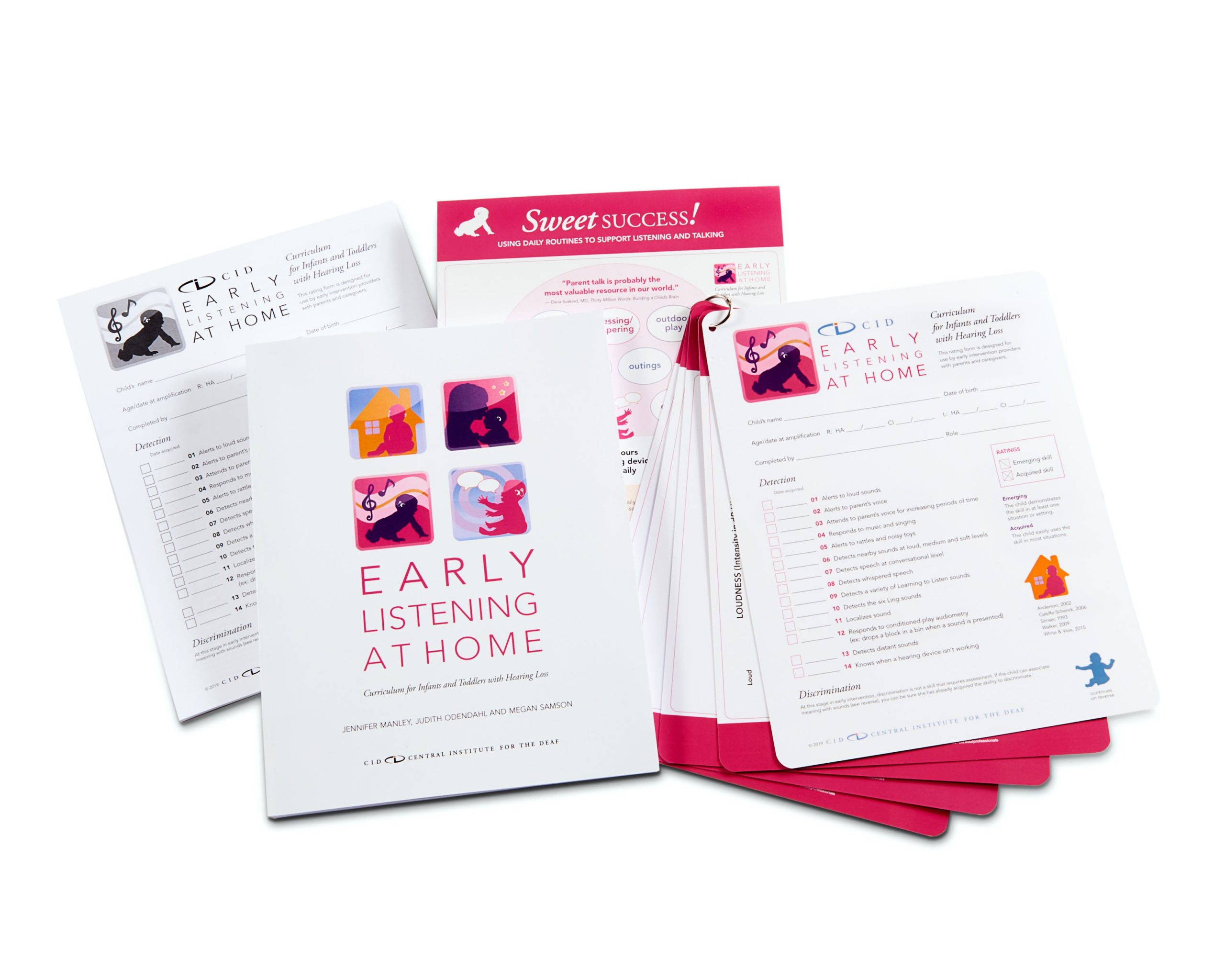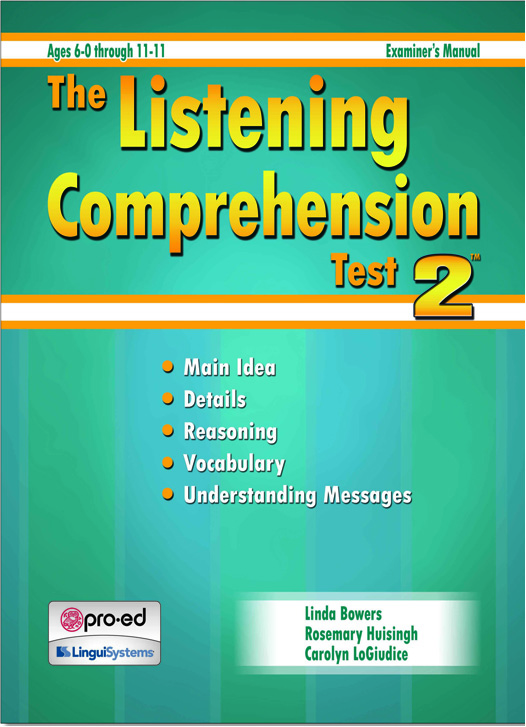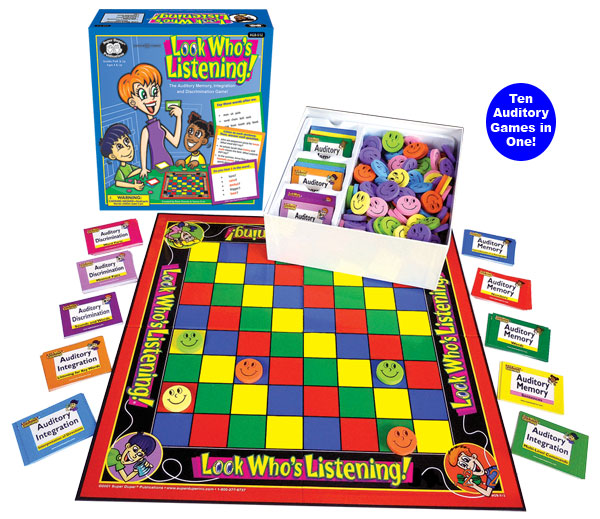Related Products
For Professionals
- Amplification
- Assessment of Student Skills, Challenges, Needs
- Early Childhood: Infants, Toddlers, Preschool
- Hearing Loss – Identification, Impact and Next Steps
- IDEA Law Summary Information
- Language and Speech Development Issues
- Legal Issues in Serving Children with Hearing Loss
- Listening (Auditory Skills) Development
- Planning to Meet Student Needs
- Self-Advocacy Skills for Students with Hearing Loss
- Self-Concept: How the Child with Hearing Loss Sees Himself
- Social Skills
- Speech Perception & Learning
Related Teacher Tools Takeout Items
Auditory Skill Practice – a MUST for Hard of Hearing Students
 Despite the technological leaps made in Hearing Assistive Technology Systems (HATS), devices like hearing aids and cochlear implants do not “fix’ the listening challenges of students with hearing loss. Incomplete auditory access usually interferes with auditory skill development therefore, children who are hard of hearing benefit from practice with listening skills1. It is up to the professionals who understand hearing loss to provide listening strategy intervention for students who are hard of hearing.
Despite the technological leaps made in Hearing Assistive Technology Systems (HATS), devices like hearing aids and cochlear implants do not “fix’ the listening challenges of students with hearing loss. Incomplete auditory access usually interferes with auditory skill development therefore, children who are hard of hearing benefit from practice with listening skills1. It is up to the professionals who understand hearing loss to provide listening strategy intervention for students who are hard of hearing.
Too often, however, teachers who work with these students don’t feel they have enough knowledge about which auditory skills are appropriate to practice and how those skills develop. New information recently added to the Supporting Success website can answer many of your questions: Listening (Auditory Skills) Development pages.
Why practice auditory skills?
Listening is essential to communicating. Many who write about the contribution of listening skills to school success cite a study by Wilt2, which analyzed how time spent communicating is broken into different activities. Wilt found that people listen 45% of the time they spend communicating, 30 % of communication time was speaking, 16% reading, and 9 % writing.
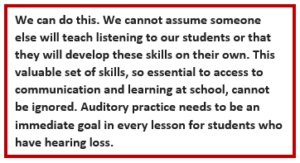 Listening practice can improve listening skills. Sweetow3 reviewed dozens of studies of auditory training and found that improvements in communication strategies—and often in sentence recognition—can be expected. When using a synthetic training approach, participants listen to spoken language, often at the sentence level, and learn to use visual cues, context and knowledge of language to understand the information.
Listening practice can improve listening skills. Sweetow3 reviewed dozens of studies of auditory training and found that improvements in communication strategies—and often in sentence recognition—can be expected. When using a synthetic training approach, participants listen to spoken language, often at the sentence level, and learn to use visual cues, context and knowledge of language to understand the information.
Listening practice is underrepresented in most general education curricula. Listening can be challenging for many students, and even more difficult for students with hearing loss. If our students are to have improve their access to communication in the classroom, discussing listening challenges and practicing listening skills must happen during their time with professionals who understand hearing loss.
Q: How can we find time to assess and practice auditory skills?
A: Apply the Speech Perception Lens to every lesson.
Auditory speech perception is the set of skills needed to understand spoken language through listening. Improvement of speech perception can lead to better comprehension and production of spoken language. If you wonder where to find the time in your daily schedule to add auditory practice, each month the Listening Strategies article in Teacher Tools provides new ready-to-use cross-curricular activities for auditory practice while also addressing common curriculum goals.
Four abilities4 comprise speech perception. Listed in order of complexity:
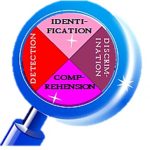
- Detect or hear sounds
- Discriminate, or recognize how spoken utterances (e.g., phonemes, words, sentences) are different from each other
- Identify, or attach meaning to, spoken utterances, and
- Use all that auditory information to comprehend discourse such as phrases, sentences and conversations
| Incorporating auditory speech perception practice into lessons that are aligned with academic objectives can take full advantage of the time the D/HH professional spends with a student, while also targeting auditory skill sets for students with hearing loss. |
If a teacher examines the task being asked of a student in a given lesson, she can determine what listening skills will be required for successful completion of the task. Taking this perspective can be likened to looking at the lesson through a “speech perception lens.”
Use the Speech Perception Lens for Error Analysis
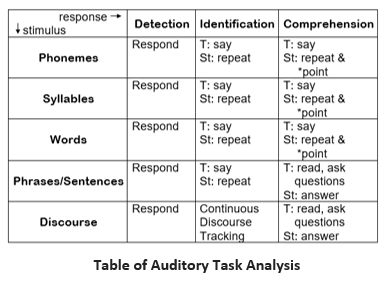 Step One: Analyze the auditory task. To examine auditory tasks, looking at the first column of this table to find the complexity level of the spoken message to which the student will listen. For an early reader, a lesson on sound-letter matching will ask the student to listen to a phoneme. In a small group or partner discussion, the student will be listening to discourse.
Step One: Analyze the auditory task. To examine auditory tasks, looking at the first column of this table to find the complexity level of the spoken message to which the student will listen. For an early reader, a lesson on sound-letter matching will ask the student to listen to a phoneme. In a small group or partner discussion, the student will be listening to discourse.
Next, determine how the student will be responding. If the student is simply indicating that she heard something, a rare task in an educational setting, the task is one of detection. If the student is expected to repeat what was heard, the task is identification. Most educational tasks require the student to demonstrate comprehension by making a choice. The choice may be within a given set of possible answers, or it may be an open choice based on information learned. The student who hears the phoneme /m/ and is expected to point to the letter m or write it, is showing comprehension of a phonemic relationship. The student who listens to a classmate’s opinion and then responds to show agreement or disagreement is showing comprehension of a sentence or discourse, depending on the length of the classmate’s statement.
Step Two: Know the essential features of vowels and consonants. Vowels vary from one another based on the location in the vocal tract in which they resonate. Vowels which resonate near one another sound similar. Consonants, however, vary based on the way in which they are produced – whether they are nasal (like /n/), require a stopping of breath (like /t/), or produce a sound caused by friction of air passing through a restricted space (like /s/). Errors are more likely to happen when listening to sounds that are produced in the same way, like /s/ and /z/. Read more here.
The Bottom Line: Do Something!
Professionals who work in a one-to-one or very small group session with students who have hearing loss can provide guided practice using materials from the student’s academic curriculum. In these sessions, the adult will be able to determine the possible reasons for an error and help the student find strategies to avoid that type of error in the classroom. New lessons and strategies for listening success can be found in the monthly Teacher Tools magazine.
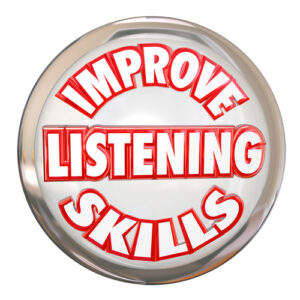
References:
- 1. Ferguson, M. A., & Henshaw, H. (2015). Frontiers in psychology, 6, 556.
- 2. Miriam E. Wilt(1950) A Study of Teacher Awareness of Listening as a Factor in Elementary Education, The Journal of Educational Research, 43:8, 626-636, DOI: 1080/00220671.1950.10881817
- 3. J Am Acad Audiol.2005 Jul-Aug;16(7):494-504. Efficacy of individual auditory training in adults: a systematic review of the evidence.
- 4. Erber, N.P. (1982). Auditory training. Washington DC: AG Bell Association for the Deaf

